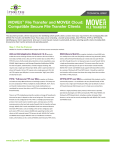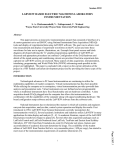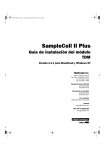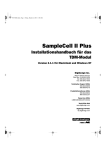Download The Realization of WSN-IP Deployment Platform
Transcript
Volume 1, No 1, February 2014 International Journal of Emerging Trends in Computing and Communication Technology Available @ www.ijetcct.in ISSN 2348 4454 The Realization of WSN-IP Deployment Platform Arif Raimi and Shamala Subramaniam, 1 Faculty of Computer Science and Information Technology 2 Sports Academy University Putra Malaysia 43400 Serdang, [email protected], [email protected], [email protected] Abstract Wireless Sensor Network with IP incorrelation with Internet of Things (IoT) enableshumans interact with devices that have unique identifiers viaa network. These enables the transfers of data over the network without requiring an explicit interaction of the human. This paper introduces a localization application realizing such abilities. The projects retrieves the current location of a user and guides the user to the locationuser intends to go. This application has been tailored subsequent indoor activity for the motivation of utilizing sensor with unique identifiers. Each of the sensors are positioned strategicallywithin an area then will connected to the access point to retrieve their own IP. The research has enable to provide a distinct inside on the deployment of an IoT project and highlights the critical issues. Keywords: wireless sensor network with IP, internet of things, mobility management, sports -------------------------------------------------------------------------------------------------------------------------------I. INTRODUCTION The advancement of the Internet of Things (IoT), has concurrent increased the need for protocolswhich connect the Wireless Sensor Network(WSN) with Internet protocols (IP). Integrating WSN with (IP) create enormous potential as there is high interaction with each other over the network to perform a certain task without requiring the human-tocomputer or human-to-human interaction. The pre-requisites IP of each device having a respective and acknowledgement the fact that we have insufficient IPs for humans. Has caused the IPv6 to privait as the suitable platform. There are two main categories of WSN-IP which are the static and mobile WSN-IP[]. There is no movement of the nodes in the static WSN-IP.Therefore, the IPs used remain the same over the transaction period. In the mobile WSN-IP, the nodes move thus the IP used constantly change subject to its location. The mobility management involved is location management and handoff management [2]. Location management refers to the procedure that isneeded for tracking the location of the Mobile Node (MN), whilehandoff management refers to the procedure that is required toallow the MN to remain connected as it moves fromone access point to another [2,3]. In Information Technology (IT), an application is defined as the use of technology, system or product[].Advocating that an application is a piece of program or software that is designed to fulfill a particular purpose. There are many types of applications that has emergedwith an enormous rise among the mess population in the world. The statistic by Gartner Incorporation, expects that total user base of consumer location-based services to reach 1.4 billion users 2014. All Rights Reserved. IJETCCT in year 2014.Apart from that, 55% of the user in the world use their smartphones to retrieve their location or recommendations places by using Location Based Services (LBS) applications [12] like Foursquare, Nearby Feed, Google Latitude, and some of the embedded application like Facebook, Instagram, and many more. These applications using the Global Positioning System (GPS) which retrievesoutdoor location accurately. The IoTrepresentrevolutionized way of utilizing the Internet to make objects, animals in addition to esscence human beings to be connected via IPs. An estimation of IoT market value is enormous, asthe definition the IoTitself spreads across devices, sensors, and computing power that overlays the entire spectrum consumers [4]. Gartner Incorporation predicts that theIoT will gradually become large in terms number of connections starting with1.9 billion devices in 2013, and predicted to become in the year 2018, 9 billion number of connections encompassing smartphones, smart TVs, tablets, wearable computers, and PCs combined [4]. There is paradigm shift from conventional human oriented networks to those which are of devices including kitchen, home appliances, lighting and heating products and insurance company-issued car monitoring devices that allow motorists to pay insurance only for the amount of driving they do. The adoption of IoT within the operations of a local map serves as the fundamental and core of this project. The definedarea for this project is the ground floor in Faculty of Computer Science and Information Technology (FSKTM) at University Putra Malaysia.This deployment is stipulated as the first phase. This building has many rooms including Arif Raimi and Shamala Subramaniam lecturer’s rooms, office, lecture hall, computer laboratory and others. As a guest or a student not familiar with orientation of this building imposes challenges to find their location and through some of the observations, many of them will ask other students or personnel of the faculty.This scenario is dependent on availability of the human supervision which causes high delay in acquiring the needed information.Therefore, the problem identifiedin this case is determining indoor location of people or things where human contact is not possible. This paper introduces a localization application for indoor activity. The main idea of this application is to retrieve the current location of the users and further assist the users to find the next indoor location or destination in same building with the pathway. Thus, it makes the user easier to find the destination within a relatively large buildingarea and short period of time as ultrasonic technology approach. These systems usean ultrasound time-of-flight measurement technique to offerlocation the information. The importantadvantageof this systems is the overall accuracy. Cricket for example,can accurately define a 4 × 4 square-feet region withina room while Active Bat can locate Bats up to 9 cm oftheir true position for a total of 95% of the overall measurements. However,the use of ultrasonic requires highcommunications in order to be efficient and accurate. However the cost is high making it inaccessible to a wide range ofusers. A substantialdetection systemusing theRFID technology is SpotON [9].This system uses an aggregationalgorithm for three dimensional (3D) location detection basedon the radio signal strength analysis. The system researchers havedesigned and built hardware that will serve as object locationtags. In the SpotONsystem, objects are located byhomogenous sensor nodes without central direct. SpotOntags use received Radio Signal Strength Indicator (RSSI) as sensormeasurement for estimating the inter-tag distance. However,a complete system has not been made available as of yet. [10] Proposes a system thatis based on the Bluetooth indoor localization system using off-the shelflow-cost stationary beacons and mobile host devices. Building the system by using a USB Bluetooth dongle, self powering hub, and aluminum cooking foil, produced a stand-alone beacon with 9m range (vs. standard 30m for Bluetooth devices)a low-cost, rapidprototyping of applications where room-level locationdetection is sufficient. This project used the methods based on thepresence of beacon signals as positioning information and haveshown to be reliable in a real world setting with greaterthan normal expected noise, in terms of electronic equipment, and others. This project has been motivated by these various technologies and has served as the underlying platform. The next section presents the details of the dealing mobile application. Figure 1: The top view of Arduino Uno Board opposed to the manual method. The next section deliberation the related work, subsequently the discussion of the hardware / software of the platform that used for this project. The next section presents the design of the system. The paper is concluded with a discussion on open issue and the conclusions. 2. RELATED WORK There is a wide area and deployment of application based on indoor location detection. 3.HARDWARE/SOFTWARE PLATFORM A RADAR based system for indoor location used for detection and tracking the users was deployed in [6]. This paper used 802.11 standard network adapter to measure the signal strengths from multiple Base Station (BS) to provide overlying coverage in a given area. This system was combined with empirical measurements and the signal propagation modeling aimed at resolving theuser location. The key strengths of this system is the ease to set up, only requires few base stations and uses the similarinfrastructure that provides general wireless networking within a building. The system has challenges wherebeing tracked and that objects has to dealing with supported by aWave LAN Network Interface card (NIC). This may be impracticalfor small or power constrained devices. In most current cases, the overall accuracy of this system which uses the 802.11 technologiesis not as optimal as desired. The Cricket Location Support System [7] andActive Bat location system [8] are two substantial examples thatuses the The platform used in this system is Android. Android is an Operating System (OS) created by Google to run on any small electronics devices such as smartphones, netbooks, tablets and others. This open source platform is a Linux based OS that is designed primarily for touch screen devices such as smartphone. This open source code and permissive licensing allows the software to be freely modified and distributed by device manufacturers, wireless carriers and enthusiast developers. By having this, our localization application project can be easily modified and enhanced in terms of functionality. The hardware component this project adapted the Arduino Uno Board as the main base. The Arduino Uno is an open source microcontroller board based on the ATmega328 (datasheet) which has 14 digital input/output pins (of which 6 can be used as PWM outputs), 6 analog inputs, a 16 MHz ceramic resonator, a USB connection, a 51 Arif Raimi and Shamala Subramaniam power jack, an ICSP header, and a reset button. It is comprehensive in terms of resources needed to support the microcontroller is connected to a computer with a USB cable Arduino Uno Board to connect to the internet via cable. It is based on the Wiznet W5100 ethernet chip (datasheet). The Wiznet W5100 provides a network (IP) stack capable of both TCP and UDP which supports up to four simultaneous socket connections. This project also used the Ethernet library to write sketches which connect to the internet using the shield. The ethernet shield connects to an Arduino board using long wire-wrap headers which extend through the shield. This keeps the pin layout intact and allows another shield to be stacked on top. The Ethernet Shield has a standard RJ-45 connection to connect to the access point, with an integrated line transformer and Power over Ethernet (PoE) enabled.There is an onboard micro-SD card slot, which can be used to store files for serving over the network. It is compatible with the Arduino Uno and Mega (using the Ethernet library). The onboard microSD card reader is accessible through the SD Library. The current shield has a PoE module designed to extract power from a conventional twisted pair.Upon this sensor being attached to the Arduino Uno Board, then need to configure it first by using the RJ45 cable on one end and attached to the workstation while the other end is attached it to the access point. Subsequently, the need to know the subnet of the network to retain the IP is explored. The next step is to change the program file that was uploaded earlier in the Arduino Uno board in oreder include the IP and the Mac Address. This is eventually uploaded again. Each of the Ethernet Shield has their own Mac Address. The completion of these steps enables the program to be run by typing the IP for this sensor at the browser to test it. The Arduino Uno Board is connected to the internet via wifi, via the WiFi Shield.This is indeed very important hardware that plays an important role in this project which is vital to make the entire sensor in the system to be connected to the access point via wifi.The shield uses WizFi210 which is a low power-consuming WIFI module applied with dynamic power management technology. When the WIFI module needs to be on but does not do any processing, it can be set to the Standby mode a low power mode. Subsequently the module needs to be woken up when it has to perform some processing. The WIFI wireless module is based on WizFi210. It provides the bridging from the TTL serial port communication to the IEEE802.11b/g/n wireless communication. So any device with the TTL serial ports can be easily connected with this WIFI module and controlled and managed remotely through a wireless network. Different kinds of communication protocols and encryption algorithms are integrated with this module.The Arduino architecture enables an easy integration into this module and into any Arduino based project. This sensor need several steps for configuration that involves need to set the SSID for target router.The need to disable the DHCP due to its WiFi enable feature, set the static network parameter, the configuration of this sensor as the TCP server then finally the testing via Putty by sending the text and receiving its reply. Among the critical,hardware that was used for this project is router. This is one of the most important tools that is Figure 2: The side view of Arduino Uno Board attached with WiFi Shield for power with an AC-to-DC adapter or battery [5].The Uno differs from all preceding boards in that it does not use the FTDI USB-to-serial driver chip [5]. Instead, it features the Atmega16U2 (Atmega8U2 up to version R2) programmed as a USB-to-serial converter.The boards can be assembled by hand or purchased preassembled. The Arduino programming language is an implementation of wiring, a similar physical computing platform, which is based on the processing multimedia programming environment.Even Arduino also simplifies the process of working with microcontrollers, but it offers some advantage for the user over other systems. This includes that it is inexpensive, assembled by hand, cross-platform, adopts a simple and clear programmingenvironment, and has extensible software.To initiate deployment, this sensor needs to be Figure3: The side view of Arduino Ethernet Shield configured first and then begins a simple program file is uploaded via USB that is attached to the workstation. Once the blink LED begins blinking, it clearly indicated that the system is working. The Arduino Uno Board has an expansion for attaching the Ethernet Shield. This Arduino Ethernet Shield allows an 52 Arif Raimi and Shamala Subramaniam indeed a pre-requisite to make the system work and for the sensorsto connect to the access point. As known fact is that a router is a device that forwards data packets between computer networks and creates an overlay internetwork. Thus, to ensure that the WiFiShield sensor is captures the data packet and the IP address from the Internet, first and foremost. The need to setup the router is essential. In this configuration stage, the router is set as its gateway of 192.168.1.1 in the subnet 255.255.255.0 which is in class C. So, all the sensors that are attached with the WiFi Shield use the IP within this network. The Arduino sensor use an open source Integrated Development Environment (IDE) that enables a convenient way to write the code and upload it to the I/O board. This IDE runs on either Windows, Mac OS X or Linux platform. Once the program is completed, and then it’s easy to upload to the Arduino Uno Board via cable by clicking the button upload in this IDE. Besides that, this environment is a user friendly approach mainly due to the low complexityonce the IDE usage installed in the workstation, it will be attached to the user manual and the tutorial inside the IDE automatically The Eclipse software is used in this project and is used to design the system interface. This software is also an IDE. It has a base workspace and an extensible plug-in system for customizing the environment. Eclipse may also be used to develop applications in other programming languages like C, C++, COBOL, FORTRAN, Haskell, JavaScript, Lasso, Perl, PHP, Python, and others. It can also be used to develop packages for the software Mathematica. Development environments include the Eclipse Java Development Tools (JDT) for Java and Scala, the Eclipse CDT for C/C++ and Eclipse PDT for PHP, among others.The initial codebase originated from the IBM VisualAge. The Eclipse Software Development Kit (SDK)usedincludes the Java development tools. Users can extend its abilities by installing plug-ins written for the Eclipse Platform, such as development toolkits for other programming languages, and can write and contribute their own plug-in modules. user is done. The reason as to placing only one action button for each interface is to make the end user easy to follow the steps and to be guided. In addition, the Android logo in this interface is just to enlighten the user this application or system is tailored for the Android platform. The second interface of this system or application is subject to the activation of the first phase. In this second interface, the system will retrieve the end user’s location. That location is only within the stipulated tested area.In this interface, the user is able navigate to the next location or places. The user will select the next location or place that in list menu that will pop-out to the user in this interface or system. Then by clicking the Go button, system will navigate the user to the next place that they want to go to. In this process the sensors play an important role as the information or data will be passed by the sensor until that current sensor find the exact sensor with the right IP address. The final interface has the mapof the tested area with the navigation information. Once the users choose the place or location intended, then without any delay this map will produce the navigation arrow with the direction accompanied with a written description at the bottom of the map. This is to ensure the user is able to be recognized the place and navigated accurately. 4. DESIGNING THE SYSTEM In this project, the designing of the system stage was an important phase. In this stage, the system was studied to capture the need of the application requirement. For this project,the basic requirement was for the user to retrieve their current position or location then navigate them to the next location. The system shall be known thereafter as UPMLBS which stand for University Putra Malaysia Location Based Service. The constraint of this application or system is that it is for the indoor and a relative or local map. The icon used for this application or system is pin where is represents the standard location symbol that is familiar if one uses the Google Maps. This system has three interfaces that user can use. This was oriented on the fact that compact would be better to make the application is fast, low delay loading the pages of the system and low power consumption as used on the mobile applications. In the first interface, the searching functionality to find the current location of the Figure 4: UPM LBS Application interface. 53 Arif Raimi and Shamala Subramaniam 5. CONCLUSION This has been indeed challenging project being a project underlying into IoT. The development time of this project was indeed consuming. Time being a significant and critical variant for this project can be divided into three main parts, which is the configuration of the sensors / hardware, designing of the system and last the testing of the system as a complete system. In the configuration task, the occurrences of errors while configuring the sensors due to the multitudes of ways to execute this. The sensors are very sensitive and configuration process is unable to be completed due to interferences and signal strength and incompatibility. The application platform imposes a vertical challenge, where each device is uniquely configured requires absolute customization. A project of this nature also have a correlation to the mobility attributes of the user. The platform of mobility impact the ability to locate the velocity of the user and the local map. In order to realize an IoT project direct correlations between the device, IP and the user attributes is of paramount importance. [5] Arduino Uno Board Review. Retrieve from http://arduino.cc/en/Main/arduinoBoardUno on (10 January 2014). [6] P. Bahl and V.N. Padmanabhan, RADAR: An inbuilding RF-based user location and tracking system, in: Proceedings of IEEE INFOCOM2000, Tel-Aviv, Israel (March 2000), http://www.research.microsoft.com/∼padmanab/pa pers/infocom2000.pdf [7] A. Harter, A. Hopper, P. Steggles, A.Ward and P.Webster, The anatomyof a context-aware application, in: Proceedings of the 5th AnnualACM/IEEE International Conference on Mobile Computing and Networking(Mobicom 1999), Seattle, WA (ACM Press, August 1999)pp. 59–68. [8] N.B. Priyantha, A. Chakraborty and H. Balakrishnan. The Cricketlocation-support system, in: Proceedings of MOBICOM 2000, Boston,MA (ACM Press, August 2000) pp. 32–43. [9] J. Hightower, C. Vakili, C. Borriello and R. Want, Design and calibrationof the SpotON ad-hoc location sensing system, UW CSE00-02-02, University of Washington, Department of Computer Scienceand Engineering, Seattle, WA, http://www.cs.washington.edu/homes/jeffro/pubs/hi ghtower2001design/hightower2001design.pdf. [10] Cheung, Kenneth C., Stephen S. Intille, and Kent Larson. "An inexpensive bluetooth-based indoor positioning hack." Proc. UbiComp06 Extended Abstracts (2006). [11] Take Nike + iPod (August 2013). Retrieve from http://www.apple.com/ipod/nike/run.html. On 12th February 2014). [12] Gartner Identifies 10 Consumer Mobile Applications to Watch in 2012. (February 2011)Retrieve from http://www.gartner.com/newsroom/id/1544815#. On 18th February 2014. 6. ACKNOLEDGMENT This research was supported in part by Science fund grant of Government Malaysia (MOSTI). REFERENCE [1] Dharma Prakash Agrawal and Qing-An Zeng, 3rd Edition of Introduction to Wireless & Mobile System. [2] IF Akyildiz, J Xie, S Mohanty, A survey of mobility management in nextgeneration all-IP-based wireless systems. IEEE WirelCommun. 11, 16–28 (2004). doi:10.1109/MWC.2004.1325888. [3] S Hong, D Kim, M Ha, S Bae, SJ Park, W Jung, J Kim, SNAIL: an IP-based wireless sensor network approach to the internet of things. IEEE WirelCommun. 17, 35–43 (2010). doi:10.1109/MWC.2010.5675776. [4] Here's Why 'The Internet of Things' Will Be Huge, and Drive Tremendous Value for People and Businesses. (7 December 2013). Retrieve from http://www.businessinsider.com/growth-in-theinternet-of-things-2013-10#ixzz2svR1Vz7G on (9 January 2014). 54
















